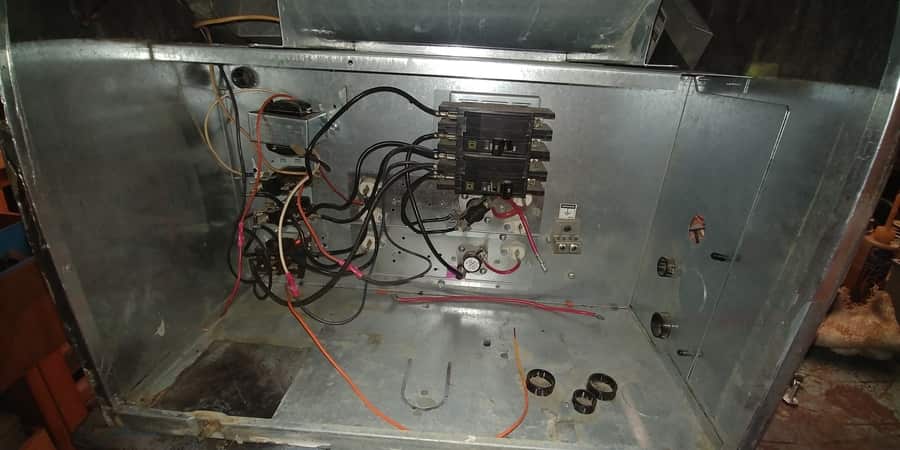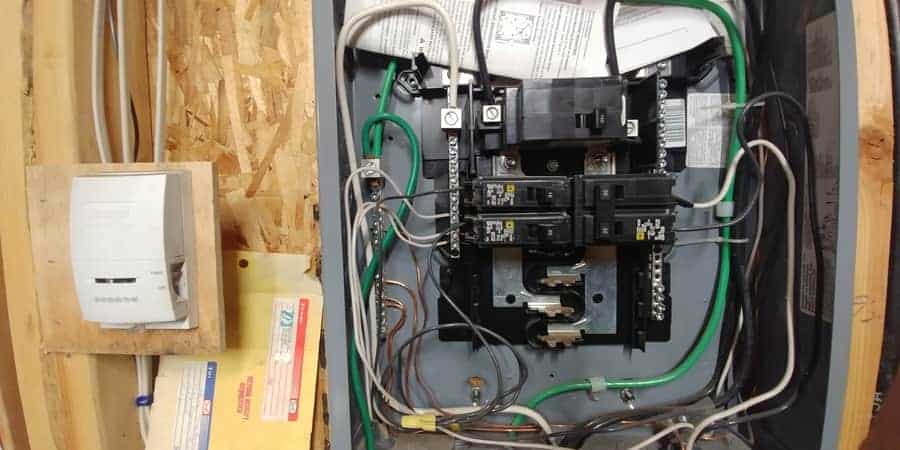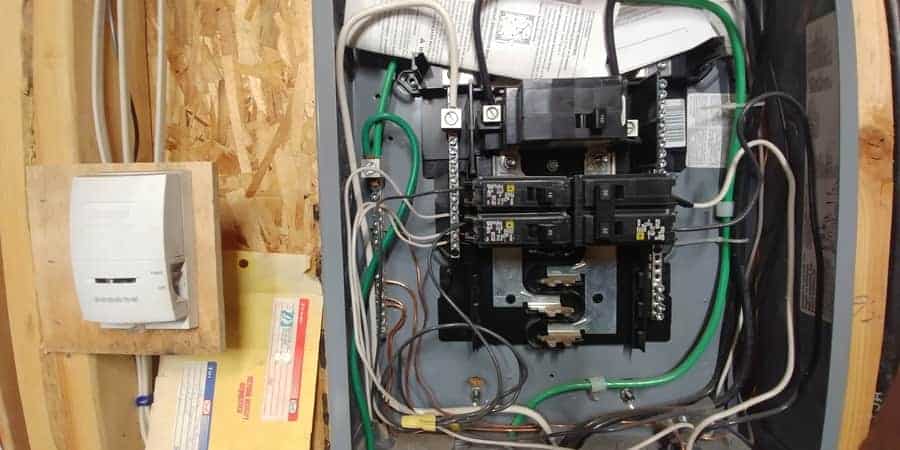Thank goodness for circuit breakers. They protect the wiring and are a primary defense in preventing fires and protecting furnace components. So what can you do to find out why the furnace breaker won’t stay on?
What is the furnace circuit breaker location that you are referring to? Electric furnaces have breakers in two locations. There should be breakers in the furnace and breakers in the main electrical panel.

Electric furnaces can have one breaker or several depending on the total wattage or number of elements in your furnace. There should be the same number of breakers in the main panel as there are in the furnace.
If your breaker that’s tripping is in the furnace or in the panel makes little difference. The reasons for them tripping are very identical.
A few reasons why an electric furnace circuit breaker keeps tripping.
- Bad or weak breaker
- Loose breaker
- Loose wire in the breaker
- Shorted wire
- Shorted furnace part or component
One easy way to diagnose a breaker, only if it has recently tripped, is to touch the breaker with the back of your fingers against the breaker. I use the back of my fingers because I’m more sensitive to heat there.
If the breaker is warmer than the other breakers in the panel then that’s probably where the problem is.
If you are not familiar with electricity then call a professional. Are you asking yourself if you should call a heating contractor or an electrician? I would call a heating and air conditioning contractor.
HVAC technicians are skilled and trained to troubleshoot electrical problems with heating equipment and by having an HVAC tech come first you are more likely to have just one service call instead of two.
Not saying that an electrician couldn’t fix the problem, just that if it’s a breaker for a furnace, then about all the electrician will check would be the breaker in the panel and the tightness of the wires.
Then you would have to call your local heating company to complete the repair and then you’d have two service calls.
Just one point of confusion would be, if the heating contractor would be allowed to work in an electrical panel because of your particular building restrictions.
Thermostat Tripping Breaker?
Not likely. You are probably witnessing a reaction. It’s called proximate and ultimate causation. The thermostat or furnace control is turning on a component or causing a load on the breaker that is causing the breaker to trip.
There is actually a separation of the thermostat power circuit and the electrical circuit that powers the furnace.

Thermostats that control electric furnaces are 24 volts and electric furnaces are powered with 240 volts. A power reducing transformer converts the 240 volts from the circuit breaker down to 24 volts to power the thermostat.
This 24 volt power has two main advantages. One is to make the control voltage safer to handle and the other reduces the wire size to make running control wires easier to run to locations in a home.
So the thermostat is probably not the circuit breaker tripping culprit. But is probably the instigator of the breaker tripping. Turning on the electric furnace at the thermostat is causing something in the furnace that is shorted to trip the breaker.
What to do if a breaker keeps tripping? The breakers are there for a reason. Constantly resetting a breaker is asking for trouble. If it trips twice or more on short occasions it’s time to get it fixed.
Something is wrong and your safety is at risk if you don’t do something now.
How Does A Furnace Breaker Switch Work?
Breakers are rated for amperage. Amperage is the load or amount of power a breaker can handle without tripping.
A breaker should have a number on the actual switch lever. If a breaker is rated for 60 amps, then it should be able to handle a constant load of 80% of that number, or 48 amps.
Breakers that run with a full load will most likely wear out sooner that those that run at 50% load or lower. But there is still the fact that a breaker is a mechanical thing and there’s no perfect answer to how long they last under what conditions.
When a breaker trips from too much load or a short circuit it’s switch sets in the middle like a loose tooth. The switch handle will just sort of flop back and forth until you flip it clear off and then it resets. If the switch won’t reset then you have a bad breaker.
You wouldn’t be able to know the actual full load of your breakers unless you had and knew how to use an amp meter. Amp meters are much different from volt meters because they don’t come into direct contact with the bare wire, they just clamp around the insulated part of the wire.
Can A Loose Wire Cause A Breaker To Trip?
Loose wires create heat and breakers are sensitive to heat and will trip. There are two basically three connections in any breaker. The connection to the panel, the switch inside the breaker, and the wire connected to the breaker.
If any of these connections become either loose or corroded the breaker will begin to generate heat. You may reset the breaker and it will operate for a short time, but then as the heat builds up it will just trip again.
That’s why it’s necessary to touch the breaker immediately after it trips and before it cools down.
Can Water Trip A Circuit Breaker?
Many times I have witnessed water in electrical panels and around breakers that are disconnects for outdoor units or air conditioners. The mast heads or the top of the pole that supplies the main power to the panel from the power pole can sometimes leak.
Water is extremely corrosive to electrical circuits and will cause the contacts from the breaker to the panel to oxidize. Also water will enter the breaker, they are not water proof.
Moisture in electrical panels is a very dangerous situation. It should be corrected immediately.
Breakers in electric furnaces can also be exposed to water. Air conditioning coils are sometimes installed directly over electric furnaces and have a habit of leaking when drains are plugged or drain pans rust through or get cracked.
These drain pans would only leak in the summer months when cooling in on and the evaporator coils are creating condensation.
Water from AC drain pans can also short out many of the electrical components of a furnace which in turn will trip a breaker.
To Wrap This Up
Circuit breakers are a critical and essential part of a home with electricity. Homeowners should have a working knowledge of what breaker powers what part of a home.
Main electrical panels should be clearly marked and accurate according to what they power. I can’t begin to tell you how many homes I’ve found incorrectly marked breakers.
In an emergency it can become very important to know what breaker needs to be turned off or on. For service technicians it’s a waste of time to have to hunt for the right breaker. You are paying him or her to find the right one.

